Applying Value Stream Mapping to Improve the Delivery of Patient Care in the Oncology Day Hospital
Abstract
:1. Introduction
2. Framework and Methodology
2.1. Framework: Health System Context and Oncology Day Hospital
2.1.1. Health System Context
2.1.2. Oncology Day Hospital (ODH)
2.2. Methodology: Value Stream Mapping
- Identifying the “family of patients” to be mapped;
- Drawing the current state map;
- Drawing the future state map;
- Designing an implementation plan to reach the future state.
- The number of ODH human resources (medical oncologists, nurses, and pharmacists) and their salaries cannot be increased;
- No changes can be made to the facilities or material resources (beds, armchairs) of the ODH;
- Changes to ODH processes that affect the processes of the entire hospital require extensive time to be implemented;
- Changes to ODH processes that involve another medical institution will be directly managed by the hospital’s chief executive officer (CEO) because some changes must be accepted by the regional government.
3. Current State Map and Analysis
3.1. Current State Map
- Patients arrive at the hospital and check in at the self-service kiosk.
- Patients wait to be called by the nursing staff.
- Patients enter the ODH to undergo blood tests. Oncology nurses are responsible for drawing and delivering blood samples to the laboratory.
- Patients go to the second floor and check in via the kiosk. Patients wait for at least 1 h before being attended by the oncologist. In the meantime, the blood samples are tested in the laboratory and the results are uploaded to the computer application.
- Patients are attended by the oncologist. Based on the results of the blood samples, the oncologist adjusts the chemotherapy treatment for the patient. This information is received by the pharmacy department, which will then prepare the medication.
- Patients return to the first level and once again they check in via the kiosk. Patients wait for more than 3 h until they start receiving chemotherapy.
- Patients enter the ODH to undergo chemotherapy. The oncology nurses are responsible for administering chemotherapy. Chemotherapy treatments may last between 15 min and 4 h, depending on the type of cancer.
- Patients go home until their next medical check-up.
- Patients have to wait to be attended despite having three scheduled appointments. These waiting times are often extended because of delays in the process.
- Patients often complain about waiting long hours at the ODH. In some cases, patients spend even more than 8 h in the ODH.
- Oncology nurses work in fits and starts. In the mornings, nurses experience higher workloads because all the patients arrive at the same time for blood collections. Then they have a “resting” period with very little work to do. Finally, patients come back at irregular intervals to be administered chemotherapy treatment.
- The job of the oncology nurses does not just involve blood specimen collection and treatment administration but they also attend to patients individually by answering their questions and by offering them human support. Oncology nurses reported that rush hour is the most complicated time to fulfill all these tasks because they need to administer treatment to too many patients. At other times, however, oncology nurses declared they have plenty of spare time. This tends to be the case on Fridays, when the type of chemotherapy treatments provided take longer and there is no free space to accommodate more patients. At these times, the seats for blood collection and chemotherapy administration are collapsed and become a limiting resource.
- Oncology nurses also stated that their workloads were systematically unbalanced. Indeed, they reported that the days on which their workloads are heavy tend to happen during the same weekdays.
3.2. Metrics
3.3. Analysis of the Current State
4. Future State Map
- Oncology nurses: working in takt time and levelling the daily workloads to avoid peaks:
- -
- Do not limit blood collections to first thing in the morning. Patients should be scheduled as evenly as possible throughout the entire day.
- -
- Administer chemotherapy treatment by starting as soon as possible and continuing throughout the entire day. As for blood collections, lags between treatments should be as constant as possible. The input (e.g., patients starting chemotherapy treatments) to chemotherapy administration will be steady and in takt time, but the output (e.g., patients leaving the chemotherapy treatment) will not be as constant because of the different durations of the treatments for each type of cancer.
- Oncologists: levelling the weekly workloads to achieve a smooth workflow:
4.1. Ideal Future State Map
4.2. Feasible Future States Maps
4.2.1. Feasible Future State 1
4.2.2. Feasible Future State 2
4.3. Benefits for the Future States Maps
- -
- Waiting times are reduced in all three future scenarios. As compared with the current state, the waiting time is reduced by 90 per cent in the ideal state, by 73 per cent in future state 1, and by 25 per cent in future state 2.
- -
- Non-added-value activity times are also consistently reduced for all three future scenarios. This is a direct consequence of the reduction on the waiting times. As compared with the current state, non-value-added times are reduced by 89 per cent in the ideal state, by 71 per cent in future state 1, and by 49 per cent in future state 2.
- -
- The length of stay is also reduced in the three future scenarios. This is a direct consequence of reducing waiting times and non-value-added activities.
- -
- The value-added rate (VAR) is increased. This is expected since VAR is the ratio between valued-added time and the length of stay.
5. Conclusions
Author Contributions
Funding
Institutional Review Board Statement
Informed Consent Statement
Data Availability Statement
Conflicts of Interest
References
- Dogan, K.; Karatas, M.; Yakici, E. A model for locating preventive health care facilities. Cent. Eur. J. Oper. Res. 2020, 28, 1091–1121. [Google Scholar] [CrossRef]
- Oppenheim, D.; Le Deley, M.C.; Pein, F.; Hartmann, O. How do parents perceive a paediatric oncology day hospital. Psychooncology 2000, 9, S94. [Google Scholar]
- Jara, C.; Ayala, F.; Virizuela, J.A. The oncology day hospital in Spain: An updated analysis of Spanish Society of Medical Oncology (SEOM) looking forward. Clin. Transl. Oncol. 2017, 19, 269–272. [Google Scholar] [CrossRef] [PubMed] [Green Version]
- Lingaratnam, S.; Murray, D.; Carle, A.; Kirsa, S.W.; Paterson, R.; Rischin, D. Developing a Performance Data Suite to Facilitate Lean Improvement in a Chemotherapy Day Unit. J. Oncol. Pract. 2013, 9, e115–e121. [Google Scholar] [CrossRef] [PubMed] [Green Version]
- Dobbs, T.E.; Guh, A.Y.; Oakes, P.; Vince, M.J.; Forbi, J.C.; Jensen, B.; Moulton-Meissner, H.; Byers, P. Outbreak of Pseudomonas aeruginosa and Klebsiella pneumoniae bloodstream infections at an outpatient chemotherapy center. Am. J. Infect. Control 2014, 42, 731–734. [Google Scholar] [CrossRef] [PubMed]
- Mor, V.; Stalker, M.Z.; Gralla, R.; Scher, H.I.; Cimma, C.; Park, D.; Flaherty, A.M.; Kiss, M.; Nelson, P.; Laliberte, L.; et al. Day hospital as an alternative to inpatient care for cancer patients: A random assignment trial. J. Clin. Epidemiol. 1988, 41, 771–785. [Google Scholar] [CrossRef]
- Levy, C.; Bouhelier, A. From yesterday to now: New galenics, new organizations and new relations in oncology day hospital. Oncologie 2014, 16, 389–392. [Google Scholar] [CrossRef]
- Benzaid, M.; Lahrichi, N.; Rousseau, L.M. Chemotherapy appointment scheduling and daily outpatient–nurse assignment. Health Care Manag. Sci. 2020, 23, 34–50. [Google Scholar] [CrossRef]
- Liang, B.; Turkcan, A.; Ceyhan, M.E.; Stuart, K. Improvement of chemotherapy patient flow and scheduling in an outpatient oncology clinic. Int. J. Prod. Res. 2015, 53, 7177–7190. [Google Scholar] [CrossRef]
- Fredendall, L.D.; Smith, J.S. Editorial: Delivering effective healthcare at lower cost: Introduction to the special issue. J. Oper. Manag. 2020, 66, 4–11. [Google Scholar] [CrossRef]
- Issabakhsh, M.; Lee, S.; Kang, H. Scheduling patient appointment in an infusion center: A mixed integer robust optimization approach. Health Care Manag. Sci. 2020, 24, 117–139. [Google Scholar] [CrossRef] [PubMed]
- Aboumater, H.J.; Winner, L.E.; Davis, R.O.; Trovitch, P.B.; Berg, M.M.; Violette, K.M.; Messersmith, W.A.; Maylor, K.K.; Lehmann, C.U. No time to waste: Decreasing patient wait times for chemotherapy administration using automated prioritization in an oncology pharmacy system. Am. J. Manag. Care 2008, 14, 309–316. [Google Scholar] [PubMed]
- Kallen, M.A.; Terrell, J.A.; Lewis-Patterson, P.; Hwang, J.P. Improving Wait Time for Chemotherapy in an Outpatient Clinic at a Comprehensive Cancer Center. J. Oncol. Pract. 2012, 8, e1–e7. [Google Scholar] [CrossRef] [PubMed] [Green Version]
- van Lent, W.A.M.; VanBerkel, P.; van Harten, W.H. A review on the relation between simulation and improvement in hospitals. BMC Med. Inform. Decis. Mak. 2012, 12, 18. [Google Scholar] [CrossRef] [PubMed] [Green Version]
- Scotte, F.; Oudard, S.; Aboudagga, H.; Elaidi, R.; Bonan, B. A practical approach to improve safety and management in chemotherapy units based on the PROCHE Programme for optimisation of the chemotherapy network monitoring program. Eur. J. Cancer 2013, 49, 541–544. [Google Scholar] [CrossRef] [PubMed]
- Lamé, G.; Jouini, O.; Stal-Le Cardinal, J. Outpatient chemotherapy planning: A literature review with insights from a case study. IIE Trans. Healthc. Syst. Eng. 2016, 6, 127–139. [Google Scholar] [CrossRef]
- Van Merode, G.G.; Groothuis, S.; Schoenmakers, M.; Boersma, H.H. Simulation studies and the alignment of interests. Health Care Manag. Sci. 2002, 5, 97–102. [Google Scholar] [CrossRef]
- Alvarado, M.; Ntaimo, L. Chemotherapy appointment scheduling under uncertainty using mean-risk stochastic integer programming. Health Care Manag. Sci. 2018, 21, 87–104. [Google Scholar] [CrossRef]
- Demir, N.B.; Gul, S.; Çelik, M. A stochastic programming approach for chemotherapy appointment scheduling. Nav. Res. Logist. 2021, 68, 112–133. [Google Scholar] [CrossRef]
- de Barros, L.B.; Bassi, L.D.C.; Caldas, L.P.; Sarantopoulos, A.; Bargas Zeferino, E.B.; Minatogawa, V.; Gasparino, R.C. Lean Healthcare Tools for Processes Evaluation: An Integrative Review. Int. J. Environ. Res. Public Health 2021, 18, 7389. [Google Scholar] [CrossRef] [PubMed]
- Rother, M.; Harris, R. Creating Continuous Flow: An Action Guide for Managers, Engineers & Production Associates; Lean Enterprise Institute: Cambridge, MA, USA, 2001; ISBN 0966784332. [Google Scholar]
- Johnson, M.; Burgess, N.; Sethi, S. Temporal pacing of outcomes for improving patient flow: Design science research in a National Health Service hospital. J. Oper. Manag. 2020, 66, 35–53. [Google Scholar] [CrossRef]
- Frangeskou, M.; Lewis, M.A.; Vasilakis, C. Implementing standardised flow: Navigating operational and professional dependencies. Int. J. Oper. Prod. Manag. 2020, 40, 1177–1199. [Google Scholar] [CrossRef]
- Ohno, T.; Bodek, N. Toyota Production System: Beyond Large-Scale Production; Productivity Press: Portland, OR, USA, 1988. [Google Scholar]
- Laganga, L.R. Lean service operations: Reflections and new directions for capacity expansion in outpatient clinics. J. Oper. Manag. 2011, 29, 422–433. [Google Scholar] [CrossRef]
- Hicks, C.; McGovern, T.; Prior, G.; Smith, I. Applying lean principles to the design of healthcare facilities. Int. J. Prod. Econ. 2015, 170, 677–686. [Google Scholar] [CrossRef]
- Bamford, D.; Forrester, P.; Dehe, B.; Leese, R.G. Partial and iterative lean implementation: Two case studies. Int. J. Oper. Prod. Manag. 2015, 35, 702–727. [Google Scholar] [CrossRef] [Green Version]
- Nabelsi, V.; Gagnon, S. Information technology strategy for a patient-oriented, lean, and agile integration of hospital pharmacy and medical equipment supply chains. Int. J. Prod. Res. 2017, 55, 3929–3945. [Google Scholar] [CrossRef]
- Hallam, C.R.A.; Contreras, C. Lean healthcare: Scale, scope and sustainability. Int. J. Health Care Qual. Assur. 2018, 31, 684–696. [Google Scholar] [CrossRef] [PubMed]
- Henrique, D.B.; Godinho Filho, M. A systematic literature review of empirical research in Lean and Six Sigma in healthcare. Total Qual. Manag. Bus. Excell. 2020, 31, 429–449. [Google Scholar] [CrossRef]
- Narayanamurthy, G.; Gurumurthy, A.; Subramanian, N.; Moser, R. Assessing the readiness to implement lean in healthcare institutions—A case study. Int. J. Prod. Econ. 2018, 197, 123–142. [Google Scholar] [CrossRef] [Green Version]
- Mangum, C.D.; Andam-Mejia, R.L.; Hale, L.R.; Mananquil, A.; Fulcher, K.R.; Hall, J.L.; McDonald, L.A.C.; Sjogren, K.N.; Villalon, F.D.; Mehta, A.; et al. Use of Lean Healthcare to Improve Hospital Throughput and Reduce LOS. Pediatr. Qual. Saf. 2021, 6, e473. [Google Scholar] [CrossRef]
- Zdeba-Mozola, A.; Rybarczyk-Szwajkowska, A.; Czapla, T.; Marczak, M.; Kozlowski, R. Implementation of Lean Management in a Multi-Specialist Hospital in Poland and the Analysis of Waste. Int. J. Environ. Res. Public Health 2022, 19, 800. [Google Scholar] [CrossRef]
- Roy, A.; Colpitts, J.; Becker, K.; Brewer, J.; van Lutterveld, R. Improving efficiency in neuroimaging research through application of Lean principles. PLoS ONE 2018, 13, e0205232. [Google Scholar] [CrossRef]
- Rocha, I.J.A.; Vasconcelos, C.R. de Lean healthcare implications in an occupational medicine clinic. Int. J. Lean Six Sigma 2021, 12, 973–991. [Google Scholar] [CrossRef]
- Cima, R.R.; Brown, M.J.; Hebl, J.R.; Moore, R.; Rogers, J.C.; Kollengode, A.; Amstutz, G.J.; Weisbrod, C.A.; Narr, B.J.; Deschamps, C. Use of Lean and Six Sigma Methodology to Improve Operating Room Efficiency in a High-Volume Tertiary-Care Academic Medical Center. J. Am. Coll. Surg. 2011, 213, 83–92. [Google Scholar] [CrossRef]
- Morell-Santandreu, O.; Santandreu-Mascarell, C.; Garcia-Sabater, J.J. A Model for the Implementation of Lean Improvements in Healthcare Environments as Applied in a Primary Care Center. Int. J. Environ. Res. Public Health 2021, 18, 2876. [Google Scholar] [CrossRef]
- Dahlgaard, J.J.; Pettersen, J.; Dahlgaard-Park, S.M. Quality and lean health care: A system for assessing and improving the health of healthcare organisations. Total Qual. Manag. Bus. Excell. 2011, 22, 673–689. [Google Scholar] [CrossRef]
- Dobrzykowski, D.D.; McFadden, K.L.; Vonderembse, M.A. Examining pathways to safety and financial performance in hospitals: A study of lean in professional service operations. J. Oper. Manag. 2016, 42–43, 39–51. [Google Scholar] [CrossRef]
- Torabi, S.A.; Pour, S.H.; Shamsi, G.N. Lean Healthcare. In Operations Research Applications in Health Care Management; Springer: Cham, Switzerland, 2018; pp. 543–568. [Google Scholar]
- Marin-Garcia, J.A.; Vidal-Carreras, P.I.; Garcia-Sabater, J.J. The role of value stream mapping in healthcare services: A scoping review. Int. J. Environ. Res. Public Health 2021, 18, 951. [Google Scholar] [CrossRef]
- Rother, M.; Shook, J. Learning to See: Value Stream Mapping to Add Value and Eliminate Muda; Lean Enterprise Institute: Cambridge, MA, USA, 1999. [Google Scholar]
- Abdulmalek, F.A.; Rajgopal, J. Analyzing the benefits of lean manufacturing and value stream mapping via simulation: A process sector case study. Int. J. Prod. Econ. 2007, 107, 223–236. [Google Scholar] [CrossRef]
- Jordan, E.; Kusar, J.; Rihar, L.; Berlec, T. Portfolio analysis of a Lean Six Sigma production process. Cent. Eur. J. Oper. Res. 2019, 27, 797–813. [Google Scholar] [CrossRef]
- Paciarotti, C.; Ciatteo, V.; Giacchetta, G. Value stream mapping implementation in the third sector. Oper. Manag. Res. 2011, 4, 99–110. [Google Scholar] [CrossRef]
- Jackson, T.L. Mapping Clinical Value Streams; CRC Press: Boca Raton, FL, USA, 2013; ISBN 1466551844. [Google Scholar]
- Vidal-Carreras, P.I.; Garcia-Sabater, J.J.; Marin-Garcia, J.A.; Garcia-Sabater, J.P. Value Stream Mapping on Healthcare. In Proceedings of the International Conference on Industrial Engineering and Systems Management (IESM), Seville, Spain, 21–23 October 2015; Framiñan, J.M., Gonzalez, P.P., Artiba, A., Eds.; pp. 272–276. [Google Scholar]
- Prado-Prado, J.C.; García-Arca, J.; Fernández-González, A.J.; Mosteiro-Añón, M. Increasing Competitiveness through the Implementation of Lean Management in Healthcare. Int. J. Environ. Res. Public Health 2020, 17, 4981. [Google Scholar] [CrossRef]
- de Souza, L.B. Trends and Approaches in Lean Healthcare. Leadersh. Health Serv. 2009, 22, 121–139. [Google Scholar] [CrossRef]
- Daultani, Y.; Chaudhuri, A.; Kumar, S. A Decade of Lean in Healthcare: Current State and Future Directions. Glob. Bus. Rev. 2015, 16, 1082–1099. [Google Scholar] [CrossRef]
- Moraros, J.; Lemstra, M.; Nwankwo, C. Lean interventions in healthcare: Do they actually work? A systematic literature review. Int. J. Qual. Health Care 2016, 28, 150–165. [Google Scholar] [CrossRef] [Green Version]
- Costa, L.B.M.; Godinho Filho, M. Lean healthcare: Review, classification and analysis of literature. Prod. Plan. Control 2016, 27, 823–836. [Google Scholar] [CrossRef]
- Parkhi, S.S. Lean management practices in healthcare sector: A literature review. Benchmarking An Int. J. 2019, 26, 1275–1289. [Google Scholar] [CrossRef]
- Zepeda-Lugo, C.; Tlapa, D.; Baez-Lopez, Y.; Limon-Romero, J.; Ontiveros, S.; Perez-Sanchez, A.; Tortorella, G. Assessing the Impact of Lean Healthcare on Inpatient Care: A Systematic Review. Int. J. Environ. Res. Public Health 2020, 17, 5609. [Google Scholar] [CrossRef]
- Crema, M.; Verbano, C. How to combine lean and safety management in health care processes: A case from Spain. Saf. Sci. 2015, 79, 63–71. [Google Scholar] [CrossRef]
- Montoya Melgar, A. Trabajo autonomo y contrato de trabajo en las profesiones sanitarias. Rev. Minist. Trab. Inmigr. 2009, 83, 7. [Google Scholar]
- Nowak, M.; Pfaff, H.; Karbach, U. Does Value Stream Mapping affect the structure, process, and outcome quality in care facilities? A systematic review. Syst. Rev. 2017, 6, 170. [Google Scholar] [CrossRef] [PubMed]
- Marin-Garcia, J.A.; Vidal-Carreras, P.I.; Sabater, J.J.G.; Escribano-Martinez, J. Protocol: Value Stream Maping in Healthcare. A systematic literature review. WPOM-Working Pap. Oper. Manag. 2019, 10, 36–54. [Google Scholar] [CrossRef] [Green Version]
- Rico, R.A.; Jagwani, J.M. Application of lean methods to compounding services in hospital pharmacy. Eur. J. Hosp. Pharm.-Sci. Pract. 2013, 20, 168–173. [Google Scholar] [CrossRef]
- Sirvent, J.M.; Gil, M.; Alvarez, T.; Martin, S.; Vila, N.; Colomer, M.; March, E.; Loma-Osorio, P.; Metje, T. Lean techniques to improve the flow of critically ill patients in a health region with its epicenter in the intensive care unit of a reference hospital. Med. Intensiva 2016, 40, 266–272. [Google Scholar] [CrossRef]
- Fernández Del Río, M. del P. La medicina de familia en seis países europeos. Atención Primaria 2010, 42, 620–625. [Google Scholar] [CrossRef] [PubMed] [Green Version]
- Garcia-Armesto, S.; Abadia-Taira, M.; Duran, A.; Hernandez-Quevedo, C.; Bernal-Delgado, E. Spain: Health system review. Health Syst. Transtion 2010, 12, 1–295. [Google Scholar]
- Gallo, P.; Gene-Badia, J. Cuts drive health system reforms in Spain. Health Policy 2013, 113, 1–7. [Google Scholar] [CrossRef] [Green Version]
- Sabater, J.J.G.; Garcia, J.A.M. Can we still talk about continuous improvement? Rethinking enablers and inhibitors for successful implementation. Int. J. Technol. Manag. 2011, 55, 28. [Google Scholar] [CrossRef]
- Shou, W.; Wang, J.; Wu, P.; Wang, X.; Chong, H.-Y. A cross-sector review on the use of value stream mapping. Int. J. Prod. Res. 2017, 55, 3906–3928. [Google Scholar] [CrossRef]
- Bleustein, C.; Rothschild, D.B.; Valen, A.; Valaitis, E.; Schweitzer, L.; Jones, R. Wait times, patient satisfaction scores, and the perception of care. Am. J. Manag. Care 2014, 20, 393–400. [Google Scholar] [PubMed]
- Carayon, P.; Gurses, A.P. Nursing Workload and Patient Safety—A Human Factors Engineering Perspective; Agency for Healthcare Research and Quality: Rockville, MD, USA, 2008.
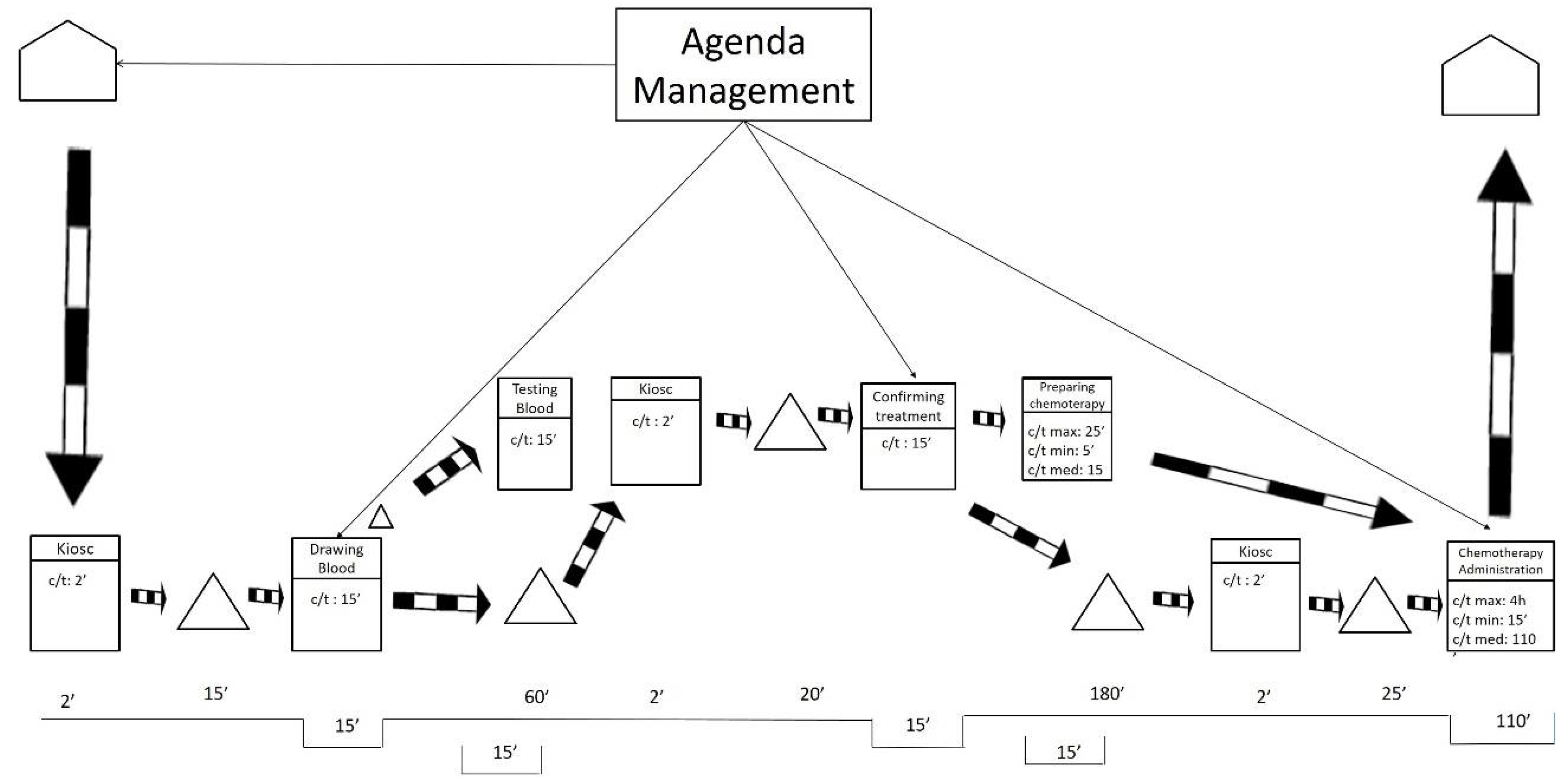

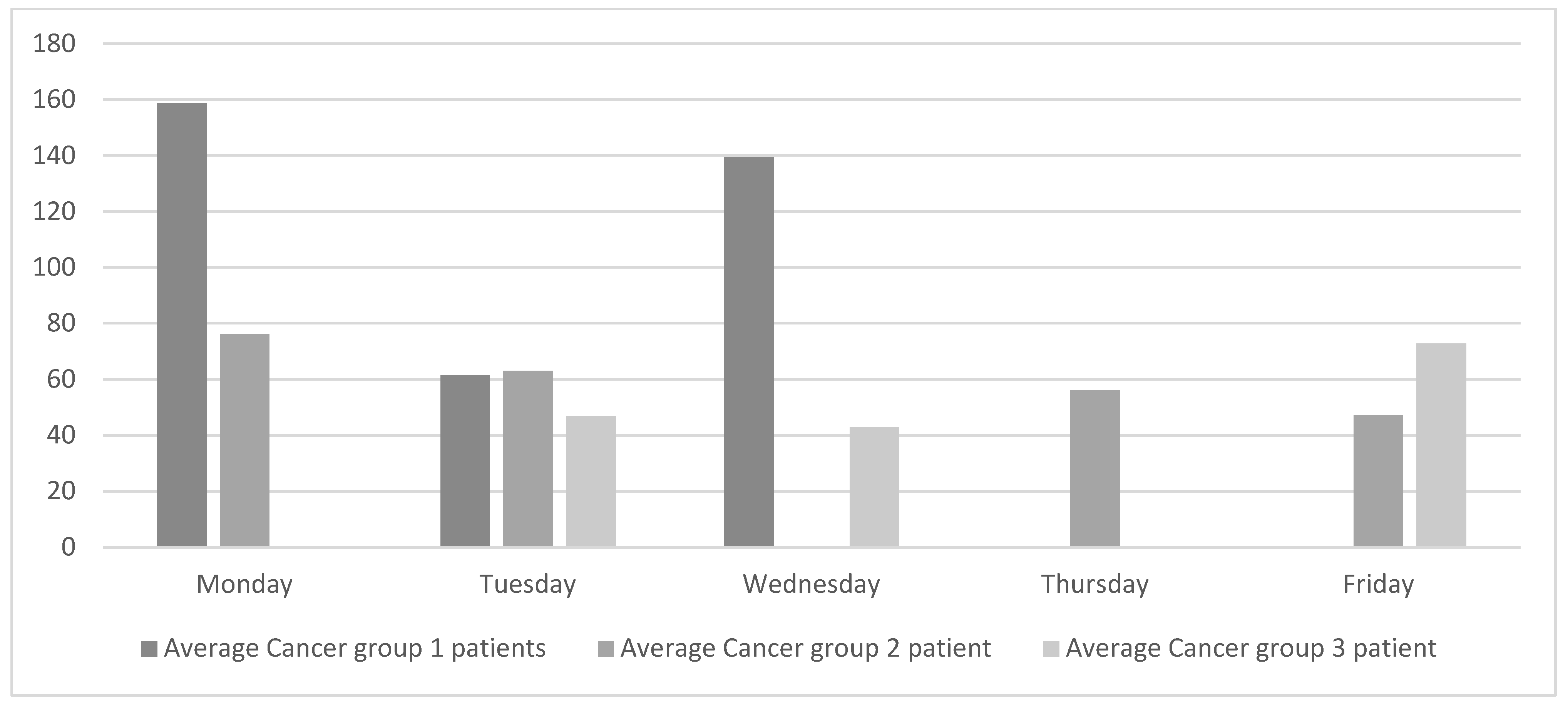
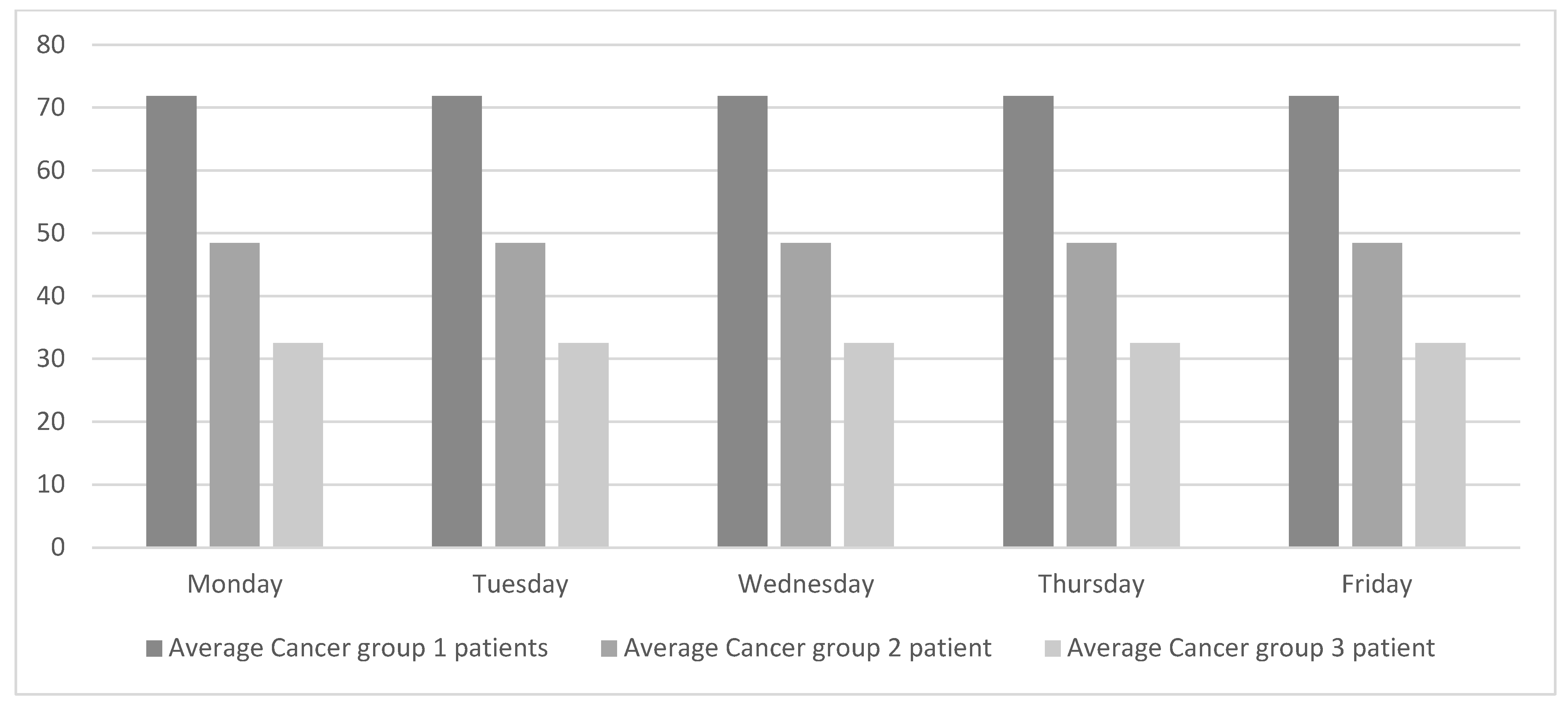
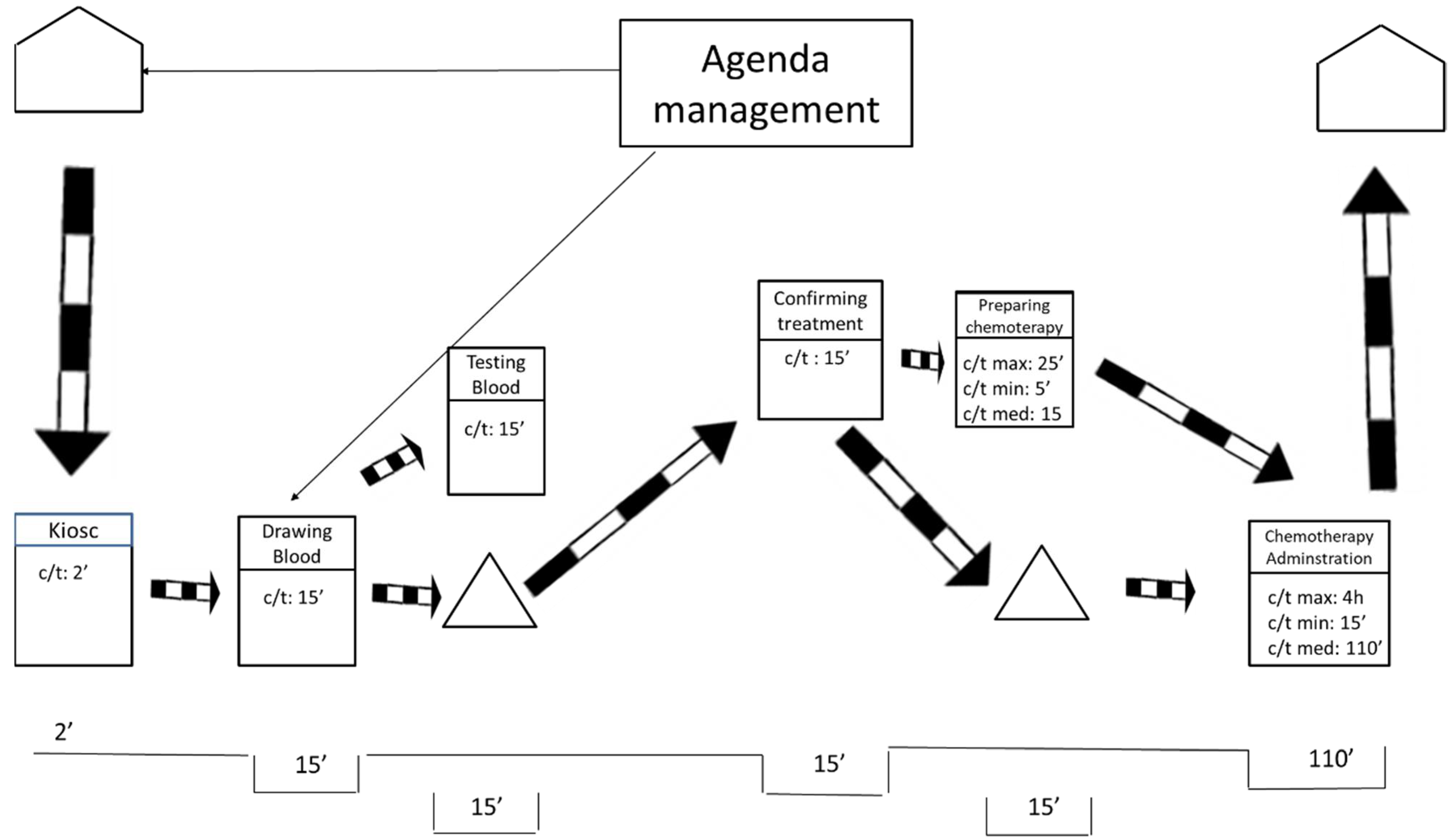
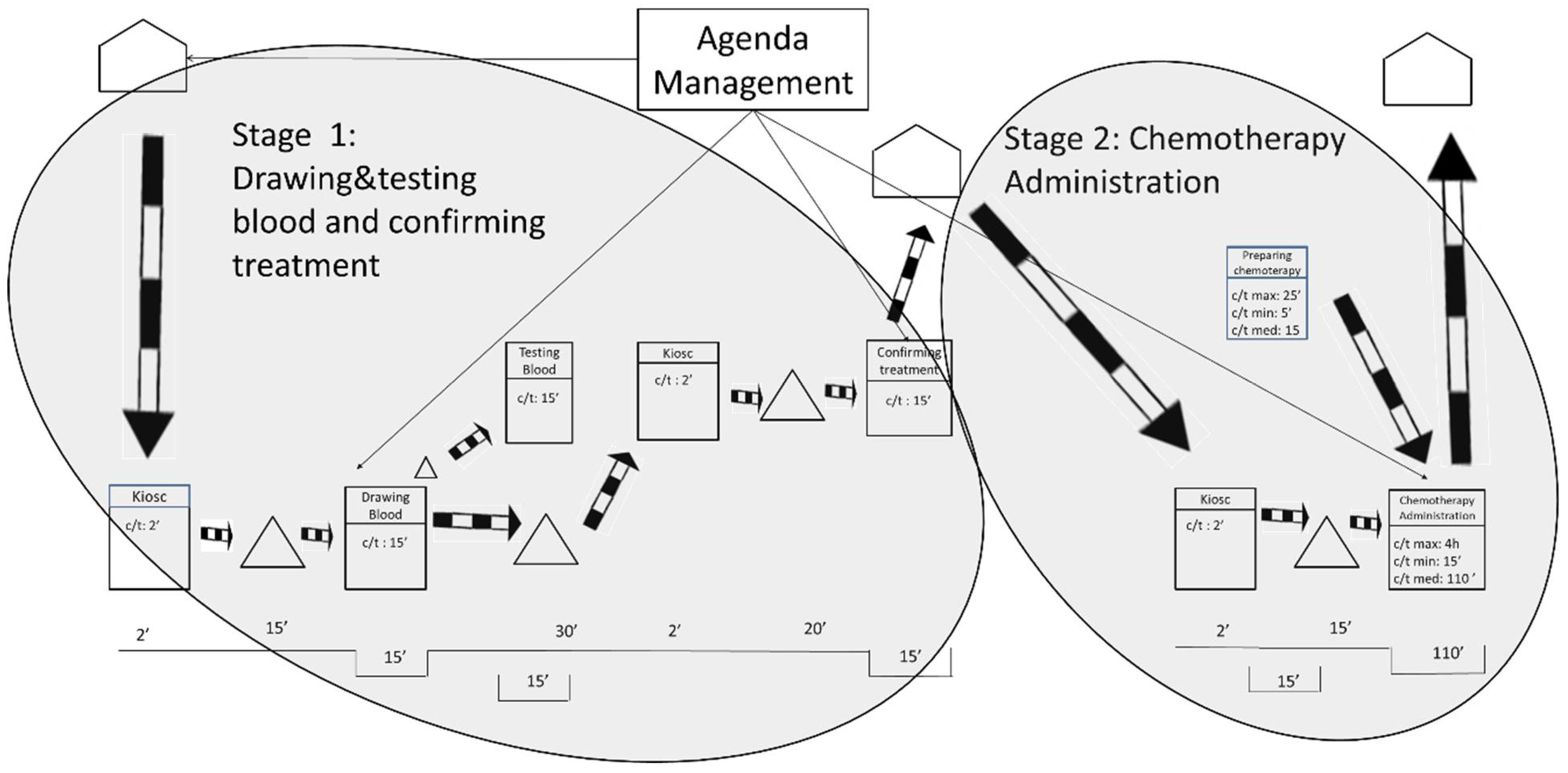
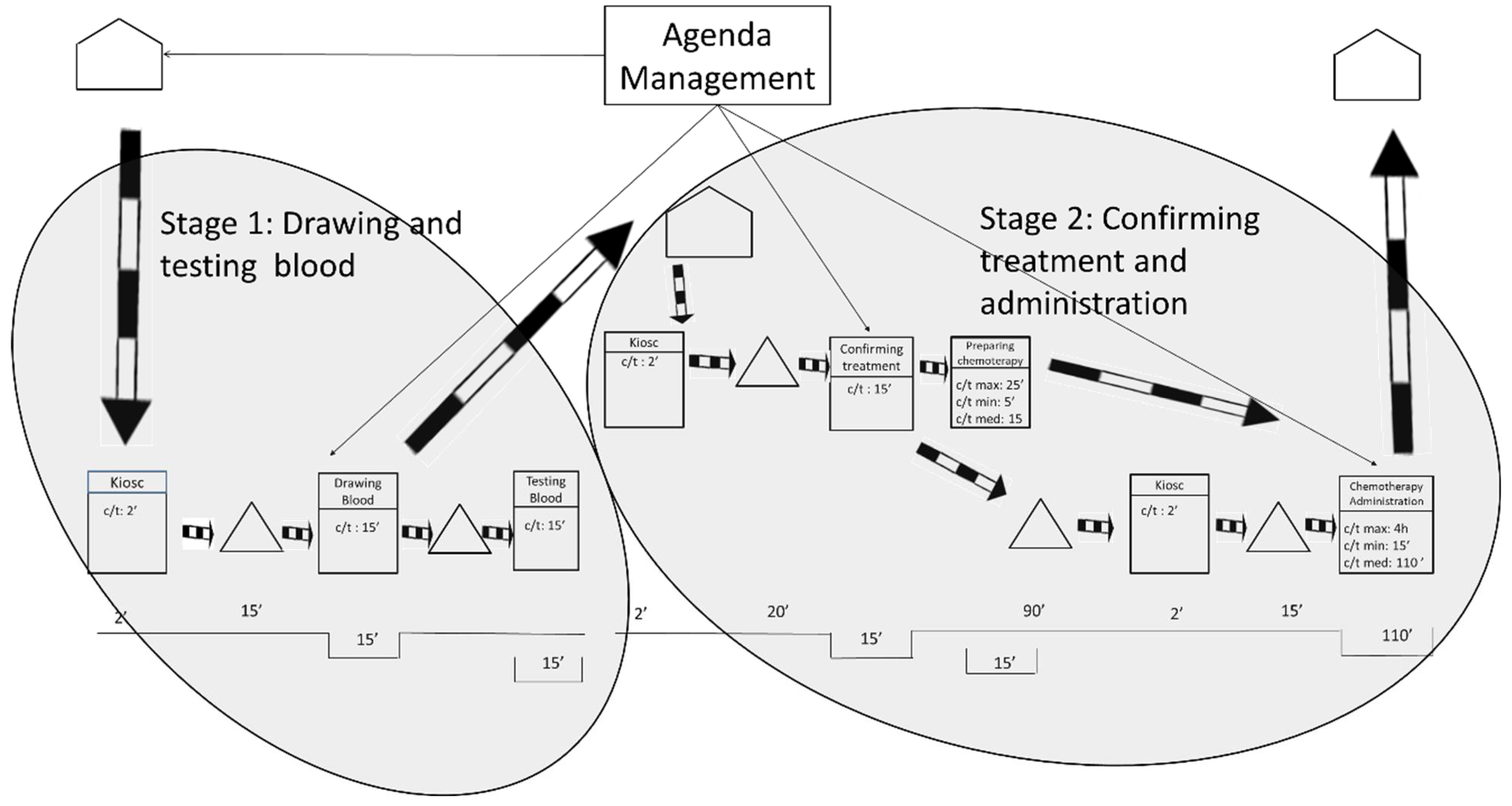
| Metrics | Wait Time (Minutes) | Non-Value-Added Time (Minutes) | Value-Added Time (Minutes) | Length of Stay (Minutes) | VAR (Value-Added Time/Length of Stay) | ||||||
|---|---|---|---|---|---|---|---|---|---|---|---|
| Min | Med | Max | Min | Med | Max | Min | Med | Max | |||
| Current state | 300 | 306 | 65 | 170 | 310 | 351 | 446 | 576 | 18.52% | 38.12% | 53.82% |
| Metrics | Wait Time (Minutes) | Non-Value-Added Time (Minutes) | Value-Added Time (Minutes) | Length of Stay (Minutes) | VAR (Value-Added Time/Length of Stay) | ||||||
|---|---|---|---|---|---|---|---|---|---|---|---|
| Min | Med | Max | Min | Med | Max | Min | Med | Max | |||
| Current state | 300 | 306 | 65 | 170 | 310 | 351 | 446 | 576 | 18.52% | 38.12% | 53.82% |
| Ideal state | 30 | 32 | 65 | 170 | 310 | 67 | 172 | 312 | 97.01% | 98.84% | 99.36% |
| Future state 1 | 80 | 86 | 65 | 170 | 310 | 131 (99 + 32) | 226 (99 + 127) | 356 (99 + 257) | 49.62% | 75.22% | 87.08% |
| Future state 2 | 150 | 156 | 65 | 170 | 310 | 201 (32 + 169) | 296 (32 + 264) | 426 (32 + 394) | 32.34% | 57.43% | 72.77% |
Publisher’s Note: MDPI stays neutral with regard to jurisdictional claims in published maps and institutional affiliations. |
© 2022 by the authors. Licensee MDPI, Basel, Switzerland. This article is an open access article distributed under the terms and conditions of the Creative Commons Attribution (CC BY) license (https://creativecommons.org/licenses/by/4.0/).
Share and Cite
Vidal-Carreras, P.I.; Garcia-Sabater, J.J.; Marin-Garcia, J.A. Applying Value Stream Mapping to Improve the Delivery of Patient Care in the Oncology Day Hospital. Int. J. Environ. Res. Public Health 2022, 19, 4265. https://doi.org/10.3390/ijerph19074265
Vidal-Carreras PI, Garcia-Sabater JJ, Marin-Garcia JA. Applying Value Stream Mapping to Improve the Delivery of Patient Care in the Oncology Day Hospital. International Journal of Environmental Research and Public Health. 2022; 19(7):4265. https://doi.org/10.3390/ijerph19074265
Chicago/Turabian StyleVidal-Carreras, Pilar I., Julio J. Garcia-Sabater, and Juan A. Marin-Garcia. 2022. "Applying Value Stream Mapping to Improve the Delivery of Patient Care in the Oncology Day Hospital" International Journal of Environmental Research and Public Health 19, no. 7: 4265. https://doi.org/10.3390/ijerph19074265
APA StyleVidal-Carreras, P. I., Garcia-Sabater, J. J., & Marin-Garcia, J. A. (2022). Applying Value Stream Mapping to Improve the Delivery of Patient Care in the Oncology Day Hospital. International Journal of Environmental Research and Public Health, 19(7), 4265. https://doi.org/10.3390/ijerph19074265






